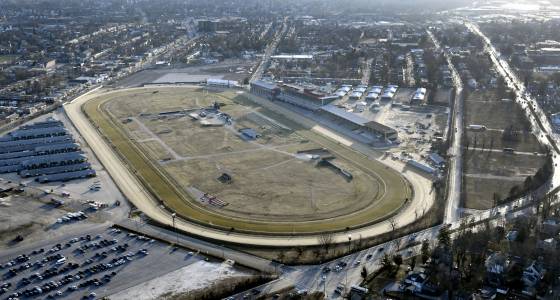It would cost $300 million to renovate Pimlico Race Course, according to a widely anticipated study to be released Friday afternoon by the Maryland Stadium Authority.
With a price established for the potential rehabilitation of the aged home of the Preakness, lawmakers and track operators say they're ready for serious discussions about who might pay for the project. Those talks could determine whether Pimlico is a viable long-term home for the state's largest sporting event, one that drew a record crowd of 135,256 and generated $94.1 million in betting handle last year.
The Stronach Group, which owns Pimlico and Laurel Park, won't foot the entire bill, said Tim Ritvo, chief operating officer for the company's racing division.
"It's going to require a huge public commitment," he said.
State and city officials are already debating how to help the Baltimore school system close a $130 million budget gap. The state is doing so amid a $544 million shortfall of its own.
Ritvo said the Stronach Group is open to discussing a public-private partnership to modernize the dilapidated, 147-year-old facility. State and city lawmakers understand that if no solution is reached, the Stronach Group could push to move the Preakness to Laurel, where the company holds the vast majority of its Maryland racing days and has invested millions of dollars in renovations.
Aerial photos from Pimlico Race Course in Baltimore. A study recently said renovating the track would cost $300M.
"I am very optimistic about the report," said Baltimore Mayor Catherine Pugh at a Friday morning appearance. "It will call for public-private partnerships and investment in the track. And we're going to do whatever is necessary, because it creates jobs and opportunities, especially for people who live in that neighborhood. We will do everything we can to ensure the Preakness stays in Baltimore."
Pugh, who confirmed the $300-million cost estimate in the report, said it's essential to invest in the neighborhood around the track in addition to the facility itself.
It would cost $300 million to renovate Pimlico Race Course, according to a study to be released by the Maryland Stadium Authority.
It would cost $300 million to renovate Pimlico Race Course, according to a study to be released by the Maryland Stadium Authority.
Sal Sinatra, general manager of the Maryland Jockey Club talks about the protocol when a horse dies after a race and the ongoing urine testing afterward. (Baltimore Sun video)
Sal Sinatra, general manager of the Maryland Jockey Club talks Deneme Bonusu about the protocol when a deneme bonusu horse dies after a race and the ongoing urine testing afterward. (Baltimore Sun video)
State law says the race can be moved to another track in Maryland "only as a result of a disaster or emergency," so the Stronach Group would likely need legislative support to run the Preakness in Laurel.
Questions about rehabilitating Pimlico have hovered for years, with track operators worrying each spring that a catastrophic problem could arise in the weeks before the Preakness, which pays for much of the rest of the annual racing calendar. In 2015, for example, water pressure problems caused the toilets to stop working on Preakness day. Worse still in the Stronach Company's view, the venerable structure cannot accommodate the luxury suites that have fueled substantial revenue growth for the Kentucky Derby in recent years.
Despite those concerns, inaction has persisted because of the perceived cost of razing and replacing a facility that will be used only a few weeks a year.
The stadium authority launched its study last spring with the backing of state legislators, the Stronach Group and the Maryland Racing Commission, an appointed panel that regulates the industry. The authority, the Baltimore Development Corp. and the Maryland Jockey Club (owned by the Stronach Group) shared the $175,000 cost of the first phase.
The report released Friday did not include specific recommendations for how to re-develop Pimlico. Those plans would be part of a potential second phase of the study, which could roll forward soon if the stakeholders ask the stadium authority to continue.
But those who've followed the long-term debate over Pimlico said the first part of the report is essential because it will force a focused discussion of the issue.
"You've got to have an informed conversation, which is what's so valuable about this," said Alan Foreman, general counsel for the Maryland Thoroughbred Horsemen's Association.
Stronach officials have said the sensible economic solution for them is to run at one track rather than two. And they've opted to spend millions of dollars to add state-of-the-art barns, luxury seating and new landscaping at Laurel, with more planned improvements on the way.
At Pimlico, meanwhile, they've paid only for modest cosmetic improvements and have pared back racing days to just 12 this year. Ritvo said the company simply makes more money running day-to-day at Laurel. He's confident that with added renovations, the facility could host a successful Preakness, though the character of the event would likely change, with no infield seating, a smaller overall crowd and a greater emphasis on selling luxury suites.
That idea is anathema to many Baltimore residents, politicians and racing traditionalists. When Ritvo and his lieutenant, Sal Sinatra, broached the idea of moving the Preakness two years ago, they faced an immediate backlash. Gov. Larry Hogan was among those who said the race should remain in Baltimore.
Ritvo said the Stronach Company is in no way determined to move the race.
"If everybody is willing to pitch in and pay for a project at Pimlico, we're willing to work with that idea," he said. "But as a purely private venture, it makes no sense for us."
He said his greatest hope is that the study will spur serious discussion among state and city lawmakers about how much of a priority rehabilitating Pimlico really is.
"I'm excited that we're talking about it and not just kicking the can down the road," he said. "Something's going to have to happen. Some tough decisions will need to be made."
Baltimore Sun reporter Yvonne Wenger contributed to this article.
Our editors found this article on this site using Google and regenerated it for our readers.












